Listening to a genuinely high-end home or car audio system can be amazing. For those who care about sound quality, several technical considerations separate a very good audio system from one that’s truly magnificent. These might be beyond what most strive for in their car audio upgrade. With that said, if your goal is a genuinely realistic music experience, these are essentially the criteria you seek. Let’s start by talking about car audio system frequency response.
What Is Car Audio System Frequency Response?
While we could dedicate a dozen articles to the topic, the concept of frequency response describes the relationship between the amplitude of different frequencies in a car audio system. A generalization would be that we want the bass, midbass, midrange and high frequencies to be balanced so that none stands out.
Car audio system design and calibration are more complicated and involved than in a home audio system. Sitting in your driveway listening to music differs significantly from driving down the road. While in motion, the vehicle generates noise from the tires, the drivetrain and the exhaust system. There’s wind noise and noise from other vehicles. Primarily, this noise resides in the lower frequency range. If we want to hear the bass information in our music over this noise, the music needs to be louder in this range.
We’ll make a clear distinction: A car audio system calibration designed to sound good while driving will not sound identical to what the recording engineer heard in the studio. There will be more bass. This doesn’t ruin the experience, as bass can be a lot of fun. However, we must remember this as we move forward with this discussion about frequency response.
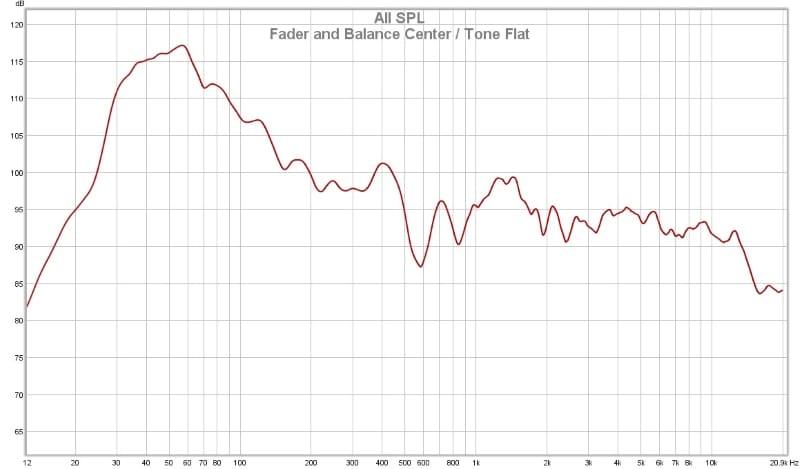
Target Response Curves
Depending on the retailer you’re working with and the brands they offer, they might have several target response curves to calibrate an audio system. These curves differ primarily in their midbass output levels, though some have different high-frequency characteristics.
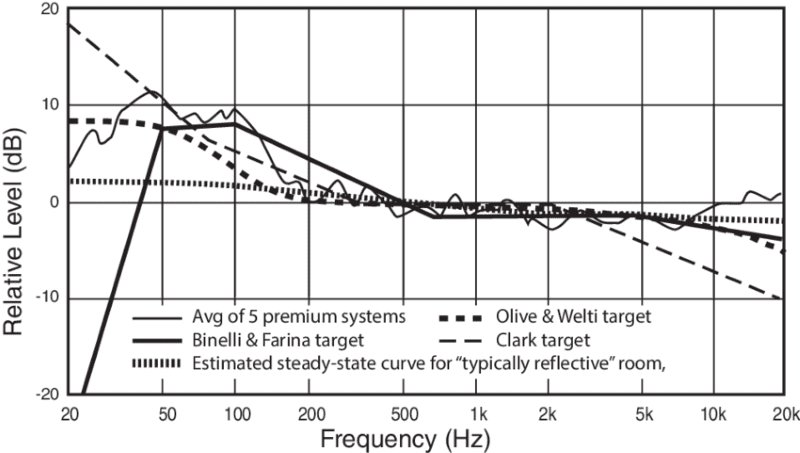
As you can see from the image above, there have been many different targets for audio systems over the years. These days, companies like Audiofrog, Harman (JBL/Infinity), JL Audio, ARC Audio and Hertz/Audison have specific response targets that are either built into their processors as a target or have been provided to their dealers as a suggested reference for system calibration.
Target Curve Discrepancies
While all the curves are similar in overall shape, the response between 100 and 500 hertz remains controversial. Let’s use the example of a well-known performer with a deep voice: Johnny Cash. While best known for his country music, his version of “Hurt” by Nine Inch Nails is popular among many music enthusiasts. His voice has no trouble reaching frequencies below 100 Hz. His voice won’t sound natural if there’s 6 dB of boost at 100 hertz.
So why do some curves have this bump in midbass response? For percussion to sound more fun. A drum like a 16-inch floor tom might be tuned to have a fundamental frequency of 80 or 120 hertz. Boosting the amplitude of those frequencies adds a lot of impact to the music. However, it does so at the detriment of vocal accuracy. This is where the discussion of personal preference comes into play. Do you want a car audio system that’s fun or one that’s accurate?
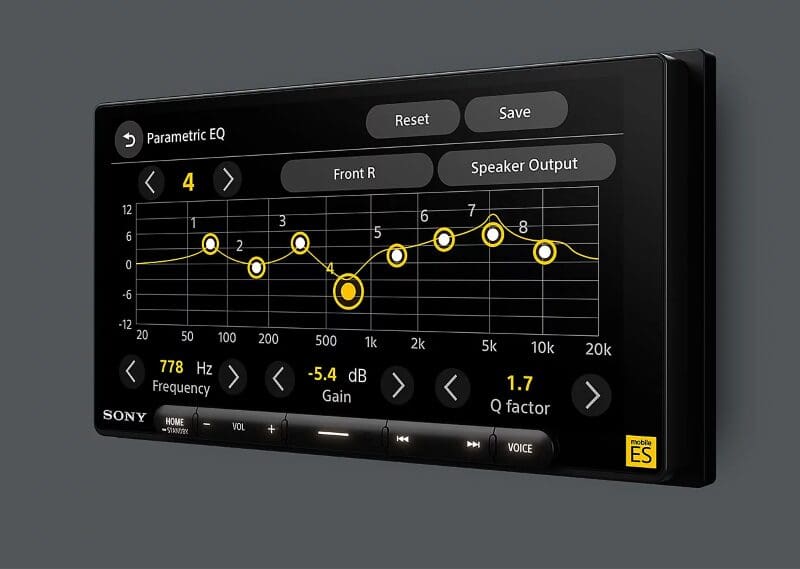
Reference-Quality Car Audio
Our team members have spent decades auditioning car audio components and audio systems of all genres – home, car, studio, theaters and live performances. We’ve heard instruments played live with no amplification and thousands of recordings with every imaginable level of processing. We each have our personal preferences for system calibration. There’s one common element: smooth midrange.
If you’re listening to Adele, Ed Sheeran, Billie Eilish, Lorde, Ozzy Osborne or Bruce Dickinson, their voices should sound real. That’s the bottom line. Billie shouldn’t sound screechy. Lorde shouldn’t sound nasally. Dickinson shouldn’t sound boomy. We listen to people speak most of the day, every day. We can tell our friends apart by the sound of their voices. It’s literally their signature. So if your goal is a high-end car audio system, getting the voices right is the number one goal. Yes, you can have more bass or slightly laid-back highs. That’s the personal preference aspect of system calibration. However, the system needs more work if voices don’t sound incredibly realistic.
How To Recreate Great Vocals in a Car Audio System
There are two primary requirements to making a performer’s vocal sound incredibly realistic: high-quality speakers and proper system calibration. As we’ve said, speakers are the most essential part of any car audio system. If you choose a low-quality speaker that doesn’t offer a smooth frequency response, the chances of unwanted distortion being added to the playback are very high. We aren’t talking about clipping but harmonic and intermodulation distortion artifacts. This information can’t be removed from the system with processing. As such, it colors or adds to the sound, making it sound less than real.
If you have a speaker with a ripple in the frequency response at 700 hertz, that’s likely a resonance in the cone, surround or dust cap. The ripple, usually represented by a small peak in the output, adds unwanted energy around that frequency. That bump is audio content that is not in the recording. It is crucial to choose speakers with ruler-flat frequency response curves and use them in the correct frequency range.

Next, your installer must ensure that your audio system is designed and configured correctly. If you have a 6.5-inch midrange in the door and it’s paired with a tweeter that can only play down to 3 kHz, the directivity characteristics of the woofer will result in the system’s frequency response being sensitive to the listening position. However, if a midrange driver that can play 300 to 3,000 hertz is added, the system will deliver smoother sound everywhere in the vehicle. The technician calibrating the system can set the two-way system for the vehicle driver’s seating position. Technically, the system must be recalibrated if the driver sits more upright or farther back. You can learn more about speaker directivity in this article.
Time Matters
The other considerations in system configuration are crossover and delay settings. We’ll spend an entire article in this series talking about soundstage position and the source of different sounds. Suffice it to say that all the music in a high-end car audio system should sound like it’s coming from a single point.
There’s a caveat to the above statement: Ninety-nine percent of the car audio industry thinks a car audio system should sound as though you’re sitting in the front row at a concert with the musicians spread out in front of you as if the dash were a miniature stage. Some consumers don’t like their audio systems to sound that way. They want to be immersed in the listening experience. This is similar to what you’d hear at a dance club or when wearing headphones.
There should be well-defined left and right channels, but the forward-to-back placement is very different. Ultimately, the music should be coherent. You want the midbass to sound connected to the vocals and the bass to connect to the midbass. The source of each frequency range should be transparent. For example, if your system has a soundstage on the dash, the midbass and bass should also sound like they’re on the dash. This is achieved using high-quality audio equipment and proper system configuration and calibration.

Why System Calibration and Frequency Response Matters
In the past, equalizers were monaural devices installed above or below a radio. Even with a dozen adjustment bands (or more), these units were more of a tone control than a correction device. Modern car audio systems with a digital signal processor can be made to sound stunningly realistic if the technician has the tools and training to complete the process properly.
In concept, all a technician must do is adjust the acoustic output of a system to match the curve. However, many techs go down the path of making unnecessary adjustments to fix peaks and valleys on the RTA that are attributable to microphone location rather than actual acoustic anomalies. A single microphone can only provide so much information, so microphone arrays are becoming more popular. Companies like Audison, with its bit Tune system, offer multi-mic solutions that give an averaged measurement of the listening environment. This can help eliminate some of those peaks and valleys and speed up the process of getting the equalizer adjustments correct.
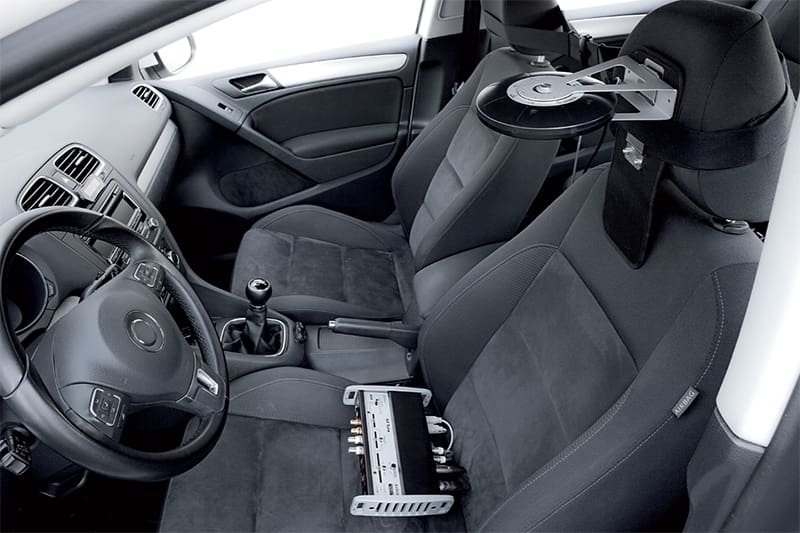
Experts Can Improve Your Car Audio System
There have been endless discussions about “the last 5%” of the calibration process regarding eking out the most realism from an audio system. Can a microphone tell you everything? No, it can’t easily measure the source of a sound. For that, human hearing is a better tool. Can a technician make a system sound amazing without any final tweaks made by ear? It’s likely, but it depends on their process. The best-sounding systems we’ve ever heard had final adjustments based on decades of experience in calibrating audio systems. These car audio systems transcend “good,” rendering voices and instruments with amazing detail, clarity and tonal accuracy. That accuracy is the result of proper system calibration concerning frequency response.
It’s amazing to hear a vocalist sound like they’re out on the hood of a vehicle with the performers spread out on either side. Achieving this takes planning, thoughtful execution and great quality products. It’s very achievable and not as expensive as many would think. Drop by several of the local specialty mobile enhancement retailers in your area and ask for a demonstration of the high-end audio systems they’ve created. Approach each experience with an open mind and ignore the make and model of the vehicle, the brands used in the installation and where components are installed. Play your favorite music, close your eyes and just listen. If the shop can deliver a more accurate presentation than others, you can move to the system design and produce selection phase for your vehicle.
This article is written and produced by the team at www.BestCarAudio.com. Reproduction or use of any kind is prohibited without the express written permission of 1sixty8 media.

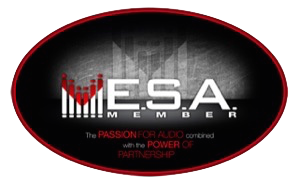
Leave a Reply